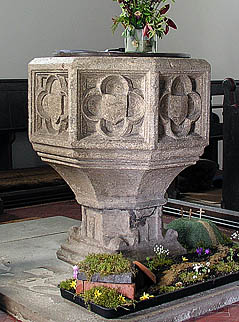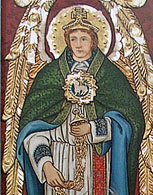Chettisham is a small village on the old road from Ely to Littleport. It has always been a small place: indeed, until 1876 there was no separate parish here at all, and St Michael was just a chapel of ease to Ely St Mary. Now that the A10 passes to the west, taking the traffic with it, the village seems to be gradually drifting off to sleep, turning into a small dormitory suburb of the nearby cathedral city.
St Michael and All Saints is a tiny church, too tiny for such a grand dedication. After its elevation to parish status in 1876, the Victorians bestowed a ghastly set of lancets for an east window, but left the body of the church intact and unextended.
Subsequent restorations have done the same, though they have also made the exterior look like the sort of chapel that found in 19th century municipal cemeteries, with the rubble walls spoiled by excessively enthusiastic mortaring.
You enter through a pleasant little porch, composed of a wooden frame resting on low stone walls. Next to it on the south wall is a bench, built between two of the buttresses, which is a nice (and unusual) touch.
Inside, the true age of the building is clearer. This is an Early English building, with thin lancets cutting through the thick nave walls, bringing very little light to the cool space.
The interior is dominated by the font; whether this is because the font is unusually large or because the nave is surprisingly small I couldn’t quite make out. It is Perpendicular, with an octagonal bowl carved with quatrefoils and shields on the faces.
It sits very low because part of the stem has been lost: below the bowl is a break, and the remains of blind arcading on the piece of stem remaining suggest that there was significantly more at one point. It’s sad to see an object like this mutilated, of course, but I quite liked the altered proportions; a low cauldron of rebirth for a small dark cavern.
Aside from that, there’s little else to say. The easternmost pews were decorated with strange Victorian paintings which Mark tried to photograph in the gloom. The church guide told us that there are four pieces of Norman sculpture preserved in the vestry, but we found no way of getting in.
Pevsner supplies brief descriptions of them: two are large pieces of capitals, one of which is decorated with chip-carving and the other with a small seated figure; one is a smaller scalloped capital, and the fourth is a lion from a corbel-table. So, nothing particularly special, but suggestive – I wonder if they came from an older building here?
St Michael and All Angels was open when we visited.




